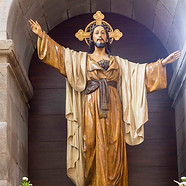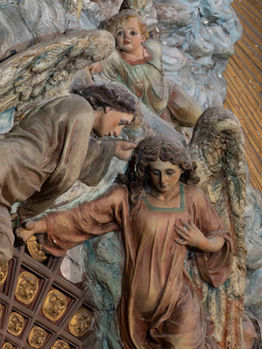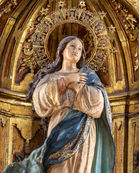
VISIT OUR CHURCH
Welcome to the Church of the Sacred Heart of Jesus, also known as the Church of St. Augustine, although its original name was the Hermitage of Our Lady of the Wall. The church is under the pastoral care of the Society of Jesus: the Jesuits. Along the following lines we intend to give some keys to visit this church and be able to pray and celebrate the Christian faith in it.
Historia
The stones of every temple hide the traces of generations past but not extinct, who, like us today, have followed a dark path to which they have chosen to shed light through faith. At every sunset and sunrise, the building is renewed, as is the human community.
Thus, the church of San Agustín was built on the site of the old hermitage of Our Lady of the Wall, whose image still presides over the entrance to the temple. We know of its existence since the 15th century, when this devotion, which takes its name from the medieval wall of the city, appears in a will.


In 1618 the Augustinian Fathers settled in this church, almost immediately commissioning the construction of the present building. The cloister was initially designed by Jácome Fernández, although we do not know if anything of what he designed survives. The present construction, however, belongs to Francisco González de Araujo and, above all, to his disciple, Bartolomé Fernández Lechuga, who in 1633 undertook to finish the temple within 6 years.
The project had the vital support of its neighbours, the Counts of Altamira, whose palace and gardens were built on the site occupied by the current market. The result is a temple of classical architecture, of great monumentality, whose façade and one of its towers were damaged by lightning in the 18th century.


Chapel of the Most Holy
Christ of the Good Death
With the arrival of the Jesuits in 1918, several reforms were undertaken, including that of this first chapel on the left. Dedicated to the Most Holy Christ of the Good Death, it features a Crucified Christ and a Recumbent Christ made by the gouge of José Rivas. This is a typical devotion of the sons of Saint Ignatius, confident that there is no eternal exile in the proximity of God, and which had its own congregation in the 1920s.
Chapel of Saint Rita of Cascia
In the second chapel on the left we find an altarpiece dedicated to Saint Rita from the Augustinian period. The saint, who was greatly devout in Santiago, fills the church and its surroundings with roses every 22nd May. The affection of generations of people from Santiago de Compostela for her maintained the temple, which was ruined and abandoned after the confiscation of church property in 1836, bringing her hope like spring flowers to a new life with the arrival of the Jesuits in 1918. As a reminder of the previous world she knew, the venerated image is flanked by Saint Augustine and his mother Saint Monica. Just below, a carving of Our Lady of Pilar.
Chapel of the Holy Family
In the third chapel on the left we find the altarpiece of the Holy Family, with a peculiar composition dedicated to holiness in the family and work context. The altarpiece was born from the reforms carried out with the arrival of the Jesuits to the temple.
Transepts of the
Immaculate Conception
and the Flagellated
Inside, Lechuga designed a church with a single nave covered by a barrel vault, with side chapels with galleries and roofed by groin vaults. He thus completed a complex that appeared narrow, which led the eye directly to the main altar, the same one that we still have today, but at that time presided over by an image of the original owner, the Virgin Mary in her title of Our Lady of the Wall.
The altarpieces in the transept are also from this same period: the Immaculate Conception, to the left of the main altar, which has been greatly modified, and the Flagellation, to the right of the same. This contains an image of Christ tied to the column at the moment of his flagellation, which is a great devotion during Holy Week in the city, whose streets are visited during the early hours of Thursday to Good Friday.
The altar of the Immaculate Conception, patron saint of the Marian Congregations, sought to place Mary as the example and protection for children and youth. For this reason, the statue of the Virgin is accompanied by those of two young Jesuit saints: Saint Stalislaus Kostka and Saint John Berchmans. Just opposite, the group is completed by Saint Aloysius Gonzaga, also a Jesuit saint and patron saint of youth, for his selfless dedication to others and his eagerness to achieve holiness.
Major Altar
The Jesuits had been expelled from Spain in 1767, leaving behind their historic home in Santiago (now the University church). After several missions at the end of the 19th century, and several temporary residences in the city, in 1918 they took charge of the old and ruined convent. The community undertook several major reforms, including the removal of the galleries, the perforation of the side chapels to bring them into line with the Jesuit layout, and the opening of new windows on the right side of the temple. The main altar is a witness to the new times, as the statue of Our Lady of the Wall disappears, its whereabouts unknown today, being replaced by an image of the Sacred Heart of Jesus, to which the temple is dedicated. It is a very dear Jesuit devotion, which places at the centre the absolute surrender of a God made hostage to his own surrender out of love.
Despite the loss of heritage, the new structure allows Mary to welcome the faithful at the door, as a welcoming mother, while the nave takes them towards the love of Christ. Under the watchful eye of the carving, the new tabernacle is built, closed by a pelican, which like Jesus, opens its chest to feed its young and allow new life to flourish in it, like that of the building itself. It is covered by a tabernacle presided over by blind faith, which is nourished by the Eucharist to find light. On either side of the main chapel there are two great teachers of faith: Saint Ignatius of Loyola, founder of the Society (whose life's pilgrimage is narrated in the Epistle nave), and Saint Francis Xavier, the great missionary of the East who fulfilled the task of going to the whole world to bring the Gospel. Both carvings are the work of the outstanding Galician master José Rivas.
Father Francisco Reino SJ
In this confessional Father Francisco Reino Salaño SJ used to devote many hours to the sacrament of reconciliation. He was a galician jesuit born in 1911 in the parish of Ortoño (Ames) and dead in Salamanca in 1944. He is remembered for his virtuous life, those who knew him remember him as a true "man of God".



Grave of Jose Rodriguez Gonzalez
Professor of Mathematics at the University of Santiago, geodesist, astronomer and director of the Royal Observatory of Madrid, naturalist and scientific traveller throughout Europe, who can be considered the first great man of science from Galicia, was buried in this Church of San Agustín on 1 October 1824, in accordance with his wishes as set out in his will.

Image of the
Sacred Heart of Jesus
Place of veneration of the image of the Sacred Heart of Jesus. With great devotion in the city, it is carried in procession through the streets of the historic centre at the end of its novena, in June. In addition to being attended by a large number of faithful, the image is accompanied by a representation of the different brotherhoods of Santiago de Compostela.


Did you like the visit?
Don't forget to leave your review on Google and come back soon. We look forward to seeing you!


































































